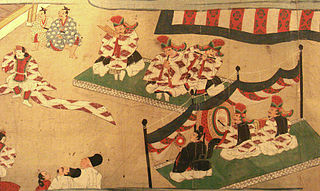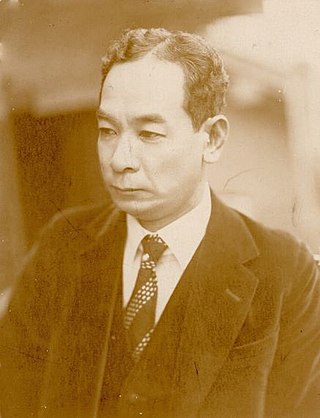
Kabuki is a classical form of Japanese theatre, mixing dramatic performance with traditional dance. Kabuki theatre is known for its heavily stylised performances, its glamorous, highly decorated costumes, and for the elaborate kumadori make-up worn by some of its performers.

Japanese traditional dance describes a number of Japanese dance styles with a long history and prescribed method of performance. Some of the oldest forms of traditional Japanese dance may be among those transmitted through the kagura tradition, or folk dances relating to food producing activities such as planting rice and fishing, including rain dances. There are large number of these traditional dances, which are often subfixed -odori, -asobi, and -mai, and may be specific to a region or village. Mai and odori are the two main groups of Japanese dances, and the term buyō (舞踊) was coined in modern times as a general term for dance, by combining mai (舞) and odori (踊).

Nihon-buyō refers to the classical Japanese performing art of dance.

The Takarazuka Revue is a Japanese all-female musical theatre troupe based in Takarazuka, Hyōgo Prefecture, Japan. Women play all roles in lavish, Broadway-style productions of Western-style musicals and stories adapted from films, novels, shōjo manga, and Japanese folktales. The Takarazuka Revue Company is a division of the Hankyu Railway company; all members of the troupe are employed by Hankyu.

Bunraku is a form of traditional Japanese puppet theatre, founded in Osaka in the beginning of the 17th century, which is still performed in the modern day. Three kinds of performers take part in a bunraku performance: the Ningyōtsukai or Ningyōzukai (puppeteers), the tayū (chanters), and shamisen musicians. Occasionally other instruments such as taiko drums will be used. The combination of chanting and shamisen playing is called jōruri and the Japanese word for puppet is ningyō. It is used in many plays.

Izumo no Okuni was a Japanese entertainer and shrine maiden who is believed to have invented the theatrical art form of kabuki. She is thought to have begun performing her new art style of kabuki theatre in the dry riverbed of the Kamo River in Kyoto. Okuni's troupe quickly gained immense popularity, and were known for their performers, who were often lower-class women Okuni had recruited to act in her all-female theatre group.

A revolving stage is a mechanically controlled platform within a theatre that can be rotated in order to speed up the changing of a scene within a show. A fully revolving set was an innovation constructed by the hydraulics engineer Tommaso Francini for an elaborately produced pageant, Le ballet de la délivrance de Renaud, which was presented for Marie de Medici in January 1617 at the Palais du Louvre and noted with admiration by contemporaries. Such a stage is also commonly referred to as a turntable.

Traditional Japanese theatre is among the oldest theatre traditions in the world. Traditional theatre includes Noh, a spiritual drama, and its comic accompaniment kyōgen; kabuki, a dance and music theatrical tradition; bunraku, puppetry; and yose, a spoken drama.
Kamigata (上方) was the colloquial term for a region today called Kansai in Japan. This large area encompasses the cities of Kyoto, Osaka, and Kobe. The term was also sometimes used to refer only to Kyoto city. The term is used particularly when discussing elements of Edo period urban culture such as ukiyo-e and kabuki, and when making a comparison to the urban culture of the Edo/Tokyo region. The term was no longer used as name for the Kansai provinces when Emperor Meiji moved to Edo in 1868. An account described Kamigata suji as one of the two regions that emerged from the division of Japan for the purpose of taxation with the other being Kwanto-suji.

Traditional Japanese music is the folk or traditional music of Japan. Japan's Ministry of Education classifies hōgaku as a category separate from other traditional forms of music, such as gagaku or shōmyō, but most ethnomusicologists view hōgaku, in a broad sense, as the form from which the others were derived. Outside of ethnomusicology, however, hōgaku usually refers to Japanese music from around the 17th to the mid-19th century. Within this framework, there are three types of traditional music in Japan: theatrical, court music, and instrumental.

The Konpira Grand Theatre, also known as the Kanamaru-za (金丸座) is a restored Kabuki theatre in Kotohira, Kagawa, on the island of Shikoku, Japan. It was originally constructed in 1835, and is the oldest kabuki theatre in Japan. Kabuki plays are performed for one month each year, usually in April.

The Hakata-za Theatre is a kabuki theatre in Fukuoka, Fukuoka Prefecture, Japan, located near the Nakasu-Kawabata Station. It was originally constructed in 1996.

Taishū engeki is a genre of popular theatre in Japan, frequently described as "light theatre", and compared to forms such as musical theatre and the revue.

Kawakami Otojirō was a Japanese actor and comedian.

Leonard Cabell Pronko was an American theatre scholar best known for introducing the Japanese dance drama kabuki to the West, beginning in the 1960s. He was a professor of theatre at Pomona College in Claremont, California, where he taught from 1957 to 2014.
Shingeki was a leading form of theatre in Japan that was based on modern realism. Born in the early years of the 20th century, it sought to be similar to modern Western theatre, putting on the works of the ancient Greek classics, William Shakespeare, Molière, Henrik Ibsen, Anton Chekov, Tennessee Williams, and so forth. As it appropriated Western realism, it also introduced women back onto the Japanese stage.

Onnagata, also oyama (女形), are male actors who play female roles in kabuki theatre.
Shinpa (新派) is a modern form of theater in Japan, usually featuring melodramatic stories, contrasted with the more traditional kabuki style. Taking its start in the 1880s, it later spread to cinema.

Kyōganoko Musume Dōjōji (京鹿子娘道成寺), commonly called Musume Dōjōji, is a kabuki dance drama. It is the oldest surviving Noh-based Kabuki dance drama, which tells the story of a maiden who dances before a bell in the Dōjō-ji temple and then reveals herself to be a serpent-demon. The work is noted for its sequence of dances during which the performer dances for nearly an hour with nine changes of costume. It may be considered the most important piece in the kabuki dance repertoire, one that the onnagatas are required to learn to show their mastery of classic dances. It is classified as one of the hengemono that involve quick change of costumes and roles. Geisha and other dancers may also learn to perform parts of the dance as solo buyō dance pieces.

Tsutsui Tokujirō (1881-1953) was a Japanese performer born in Osaka, Japan.
















